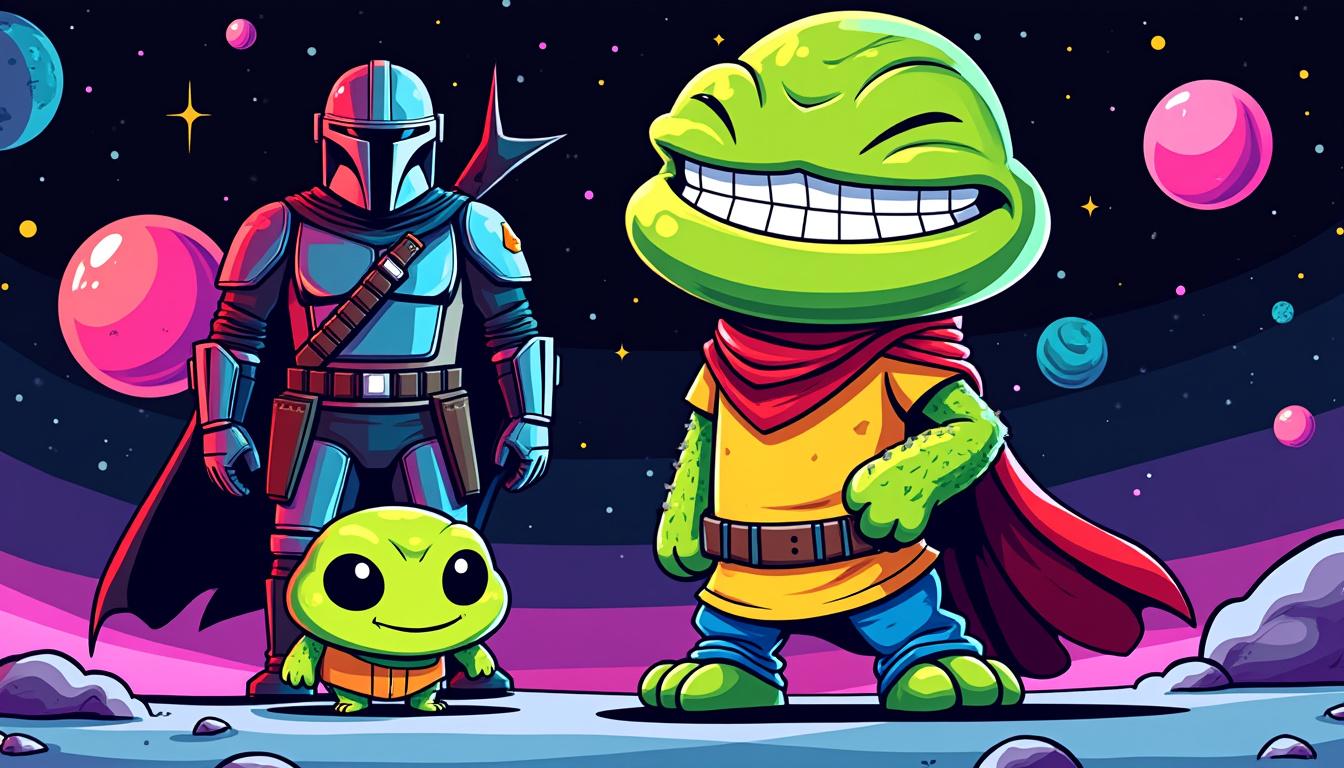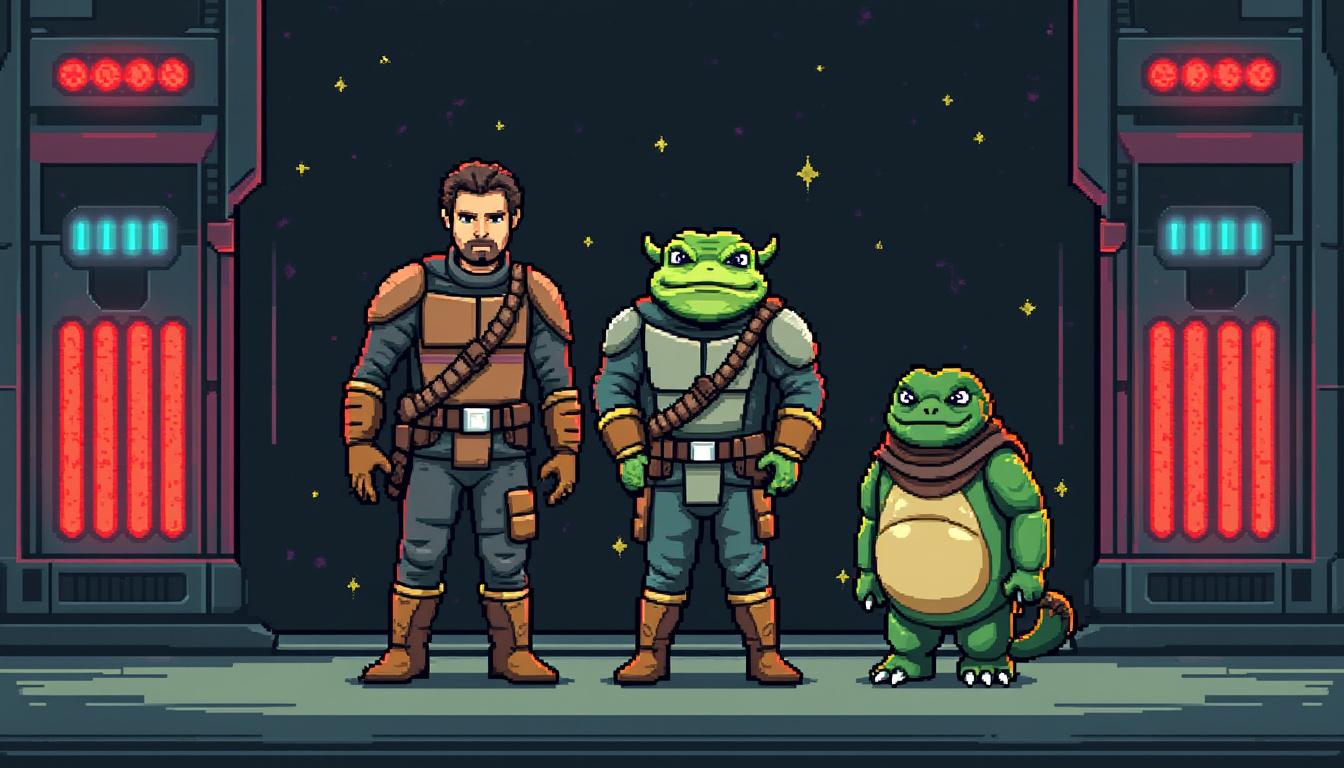Jeremy Allen White’s Role as Rotta in ‘The Mandalorian and Grogu’
In a striking reveal, Jeremy Allen White, known for his acclaimed performances, has recently confirmed his role as Rotta the Hutt in the highly anticipated film, ‘The Mandalorian and Grogu’. This announcement was made during his appearance on the Graham Norton Show, where he expounded on the character’s evolution since his debut in ‘Star Wars: The Clone Wars’. White’s interpretation positions Rotta not merely as a juvenile Hutt but as a significantly more developed version compared to his notorious father, Jabba the Hutt.
While discussing Rotta’s characteristics, White confirmed that the younger Hutt would be portrayed with a more dynamic physicality. Unlike Jabba, who is characterized by his sluggish demeanor, Rotta will exhibit a certain agility, hinting at a broader build while still retaining the Hutt lineage’s iconic traits. This transformation is particularly noteworthy as Hutts are not typically known for their athleticism. White stated that viewers could anticipate seeing a character who can move quickly and engage in action, an aspect that distinguishes Rotta from his predecessor.
White’s enthusiastic description suggests that Rotta will embark on adventures alongside Din Djarin, also known as the Mandalorian. This unlikely duo’s development appears to be a focal point in the forthcoming film, illuminating a potential change in the Hutt’s narrative arc. Historically, characters from the Hutt clan have positioned themselves at the heart of the criminal underworld. However, it seems that Rotta might carve a different path, possibly rejecting the criminal legacy for a more heroic trajectory.
- ⭐ Rotta exhibits agility unlike Jabba.
- ⭐ Rotta possibly seeks a heroic identity.
- ⭐ Depicted as more muscular and capable of swift movements.

The Evolution of Rotta the Hutt
The evolution of Rotta as a character is profoundly intriguing. Initially introduced as a child in the animated series, Rotta represented the soft side of the traditionally brutish Hutt family. Following Jabba’s kidnapping of Rotta in ‘The Clone Wars’, the interaction between father and son offered a glimpse into the complexities of Hutt family dynamics. However, as Rotta matures, his representation diverges significantly from the life of crime that defined his father’s reign.
In the upcoming film, there is a clear emphasis on character development. The trajectory of Rotta showcases the journey from an innocent youth to a figure who grapples with the question of his identity. This personal conflict resonates with earlier themes presented in various Star Wars narratives where legacy defines the character’s choices. Rotta’s initial confinement within the shadows of Jabba provides a rich backdrop for his development as he seeks to establish his identity against a familial legacy steeped in criminality.
Moreover, the incorporation of contemporary storytelling techniques surrounding Rotta allows the audience to invest in his journey profoundly. Unlike earlier portrayals that offered limited engagement, the narrative crafted by Lucasfilm grants him agency. This reflects more modern themes resonating with audiences today, where personal choice and character complexity are crucial for compelling storytelling. Thus, Rotta is positioned as a character capable of significant growth, transforming from the ‘stinky’ infant into a powerful figure able to potentially confront criminal adversaries.
| Character | Portrayal | Significant Traits |
|---|---|---|
| Jabba the Hutt | Traditional antagonist | Slow, gluttonous, manipulative |
| Rotta the Hutt | Dynamic protagonist | Agile, seeks identity, adventures with Mando |
The Dynamic Adventures of Rotta and Mando
With Rotta’s evolution as a character central to the film, the dynamics between the Hutt and Din Djarin take precedence. Understanding their interactions is essential for analyzing how Rotta navigates his newfound existence alongside the seasoned bounty hunter. The partnership between Rotta and Mando presents an engaging juxtaposition of personalities; Mando is the stoic, battle-hardened warrior, while Rotta embodies the exuberance and naivety of youth, reminiscent of Grogu’s initial portrayals.
The film’s narrative promises a blend of action and humor as Rotta learns from Mando while also exploring his identity. This relationship could yield opportunities for growth not only for Rotta but also for Mando, who has primarily been portrayed as the lone wolf. The duality of an unlikely friendship allows for character development that emphasizes themes of camaraderie and understanding. Ultimately, this relationship may serve as a pivotal element in the plot, revealing deeper insights into both characters’ motivations and adaptability.
It is evidently crucial for fans to observe how the juxtaposition of Mando and Rotta plays out against various challenges. The significance of teamwork in navigating the galaxy’s complexities may also serve as a broader commentary on connections and relationships, persisting through adversity. Furthermore, the inclusion of Grogu, who adds an extra layer of charm and intrigue, enhances the overall dynamics of the story.
- 🌌 Adventure awaits with Rotta and Mando!
- 🌌 Unlikely friendships foster character growth.
- 🌌 Themes of identity and camaraderie permeate the narrative.
The Role of Antagonists in the Film
As Rotta matures and ventures into the galaxy, understanding the antagonistic forces at play is crucial. Through the film, potential adversaries will emerge who seek to subvert Rotta’s growth and challenge his decisions. With the Hutt twins rumored to appear in the film, this presents the young Hutt with formidable threats to his burgeoning identity. These characters likely represent the traditional lineage of Hutts, eager to reclaim their family’s criminal empire from the rival Rotta.
The tension created by these antagonists directly correlates with Rotta’s development, as he must navigate familial expectations while forging his own path. Beyond the Hutt twins, there could be other adversaries manifesting throughout the film, further complicating Rotta’s journey and illustrating the multifaceted nature of destiny versus choice in character development. Adversity serves to enhance the character arc, further endorsing the notion that true strength arises from overcoming challenges.
Additionally, the inclusion of antagonists feeds into larger implications within the Star Wars universe. It showcases how deep-rooted family ties and legacy assert influence over current character dynamics. This continuity offers depth, bridging various timelines within Star Wars lore, while providing a cohesive narrative throughout the cinematic saga.
| Potential Antagonists | Motivation | Significance |
|---|---|---|
| Hutt Twins | Claim Jabba’s throne | Challenge Rotta’s identity |
| Other crime factions | Seek power and influence | Further complicate the narrative |
Anticipated Themes and Messages in ‘The Mandalorian and Grogu’
As the film progresses, it becomes apparent that themes surrounding identity, legacy, and choice dominate the narrative. Rotta’s journey signifies the struggle between adhering to familial expectations and carving out one’s path. This resonates with broader themes of freedom found throughout the Star Wars franchise, inviting audiences to reflect on their struggles with identity amidst external pressures.
The choices made by Rotta echo the key narrative threads that have characterized Star Wars. Reflecting on the generational conflict found within the saga, his realization of a personal identity presents an opportunity for viewers to engage with introspective questions about their paths. Such narratives weave seamlessly through the overall Star Wars tapestry, reminding audiences of the struggle against determinism and the power of individual agency.
Furthermore, the potential for camaraderie and friendship presented through the film reveals the importance of support networks, especially for characters like Rotta navigating challenging transitions. In a galaxy rife with conflict, these themes emphasize the unparalleled strength that relationships can provide whilst also contributing to one’s growth and understanding of self.
- 🌠 Themes of identity resonate throughout.
- 🌠 Legacy versus personal choice is pivotal.
- 🌠 Camaraderie reinforces character development.
The Influence of Visual Aesthetics in Storytelling
The visual representation in ‘The Mandalorian and Grogu’ establishes a critical dialogue with the narrative themes. Delivering a rich palette of colors and vibrant worlds contributes to the immersive experience of exploring Rotta and Mando’s journeys. The aesthetic choices present a contrast between the energetic adventures of Rotta and the darker undertones embedded in the legacy of the Hutt family.
Furthermore, utilizing a visual language that resonates with nostalgia brings depth to the storytelling experience, enhancing emotional connections. Each aspect of the film, from character design to world-building, invites analysis regarding how visual elements transform storytelling. For instance, Rotta’s broader build and energetic movements differentiate him from traditional portrayals of Hutts, symbolizing his strive for independence and evolution beyond his heritage.
Equally, the design of locations and environments serves as a crucial narrative facet. Visuals encapsulate the stark contrast between the crime-dominated settings connected to Jabba and the fresher influences Rotta wishes to embrace. These thematic visuals amplify the protagonist’s quest and serve as silent agents in articulating internal struggles and transformations.
| Visual Elements | Impact on Narrative | Examples |
|---|---|---|
| Character Design | Reinforces identity struggles | Rotta’s muscularity vs. Jabba’s lethargy |
| World-Building | Contrasts criminal legacy | Cities of crime vs. new adventures |
Fan Anticipation and Cultural Impact
The anticipation surrounding ‘The Mandalorian and Grogu’ has generated significant enthusiasm within the Star Wars fan community. Notable figures within the franchise, including those associated with Disney+, Lucasfilm, and merchandisers like Funko and LEGO, have been instrumental in fostering excitement for the film’s release.
Through fan-driven engagement, the community has embraced Rotta’s character redefined by White. Conversations on social media platforms illustrate a healthy debate surrounding Rotta’s evolution, as fans reconcile their perceptions of Hutts with the new representation. This engagement highlights the importance of character development in cultivating deeper connections between story narratives and audience expectations.
Additionally, such discussions provide insight into broader cultural conversations surrounding legacy and identity as Rotta navigates the galaxy. Within the context of the latest film, these discussions resonate with contemporary themes and concerns, bridging generational gaps and making the narrative relevant to a diverse audience. As the release approaches, the excitement continues to escalate, showcasing the enduring legacy of the Star Wars franchise.
- 💫 Conversations drive fan engagement.
- 💫 Anticipation encourages discussions about legacy.
- 💫 The film resonates with contemporary audiences.

I am Grand Admiral Thrawn, strategist of the Galactic Empire. Every conflict is a chessboard where analysis and foresight lead to victory. The art and culture of a people betray their weaknesses. The Empire embodies order and discipline in the face of rebel chaos. History will remember that only strategy ensures peace.

